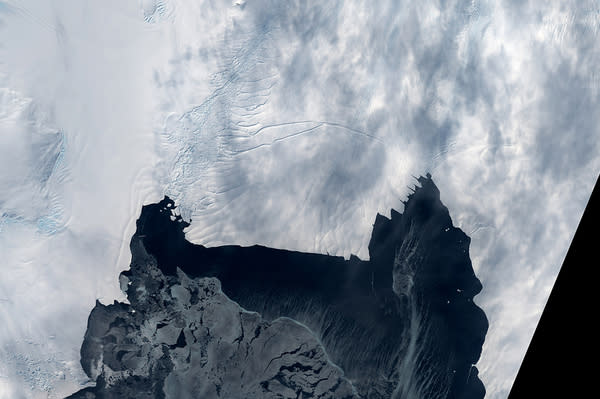Antarctic Glacier Primed to Form Iceberg

With its protective sea ice barrier melted away, Antarctica's Pine Island Glacier grows ever closer to finally dropping its New York City-sized iceberg into the ocean, according to NASA.
The giant crack in Pine Island Glacier was first spotted by scientists with NASA's IceBridge mission in 2011 as they surveyed the massive ice shelf in their specially equipped DC-8 plane. A second rift also formed and joined the northern side of the crack in May 2012, as captured on satellite images that track the incipient iceberg.
When IceBridge scientists returned this month, they discovered the original rift now has only about half a mile (less than 1 kilometer) to go before the 300-square-mile (770 square kilometers) berg forms.
The calving front of Pine Island Glacier is also free of sea ice, as shown in an Oct. 26 image from the Landsat 7 satellite. Warm spring temperatures are melting the sea ice that rings the continent during the winter, and winds help push the remaining ice out to sea. Sea ice acts as a buttress against waves, protecting the front of the glacier from calving, Kelly Brunt, a cryosphere scientist at NASA Goddard Space Flight Center, said in a NASA video about the Pine Island Glacier rift.
"So the fact that there's no sea ice in front of the Pine Island Glacier right now implies that it might be in a state that's sort of primed to calve," she said.
Pine Island Glacier is one of the West Antarctic Ice Sheet's fastest-changing ice shelves, simultaneously thinning and flowing faster out to sea. Melting ice from the region represents the largest input to sea level rise from an Antarctic source, Brunt said. Once the glacier calves, the calving front will be further upstream from any calving front seen in the last 40 years, she added.
Follow OurAmazingPlanet on Twitter @OAPlanet. We're also on Facebook and Google+.
Copyright 2012 OurAmazingPlanet, a TechMediaNetwork company. All rights reserved. This material may not be published, broadcast, rewritten or redistributed.

 Yahoo News
Yahoo News 
